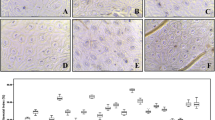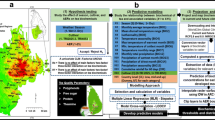Abstract
Climate change differentially affects tea yield at various altitudes; however, its impact on tea quality is less acknowledged. To understand the divergence in tea quality, we collected green tea samples from five sites (with varying altitude from 212 to 1020 m) on Lushan Mountain in Jiangxi Province, eastern China. Results showed that an increase in cultivation altitude decreased total tea polyphenols (TP) but increased amino acids (AA) concentration, leading to a remarkable decrease in TP/AA, one of the most important parameters that determine the taste of green tea. The constituents of AA, especially theanine, glutamic acid, arginine, serine, γ-aminobutyric acid and aspartic acid increased with increasing elevational gradients. Nonetheless, the constituents of polyphenolic compounds, especially individual catechins, were differentially altered with the change in cultivation altitude. In particular, with increasing elevation, the epigallocatechin-3-gallate and epicatechin gallate decreased, while the epigallocatechin and gallocatechin gallate increased, that eventually caused no significant variation in the total catechins in different sites. Additionally, the percentage of catechins to TP was increased with increasing altitude. Given that temperature is being increased due to climate change, rising temperatures particularly at lower altitude, perhaps, will deteriorate tea quality as a consequence of climate warming. This observation demands development of effective measures for sustaining green tea quality in the face of climate change.

Similar content being viewed by others
References
Macfarlane A, Macfarlane I (2004) The empire of tea: the remarkable history of the plant that took over the world. Overlook Press, New York
Tounekti T, Joubert E, Hernández I, Munné-Bosch S (2013) Improving the polyphenol content of tea. Crit Rev Plant Sci 32(3):192–215. doi:10.1080/07352689.2012.747384
Xu W, Song Q, Li D, Wan X (2012) Discrimination of the production season of Chinese green tea by chemical analysis in combination with supervised pattern recognition. J Agric Food Chem 60(28):7064–7070. doi:10.1021/jf301340z
Liu M, Tian H-l WuJ-H, Cang R-R, Wang R-X, Qi X-H, Xu Q, Chen X-H (2015) Relationship between gene expression and the accumulation of catechin during spring and autumn in tea plants (Camellia sinensis L.). Hortic Res 2:15011. doi:10.1038/hortres.2015.11
Kaneko S, Kumazawa K, Masuda H, Henze A, Hofmann T (2006) Molecular and sensory studies on the umami taste of Japanese green tea. J Agric Food Chem 54(7):2688–2694. doi:10.1021/jf0525232
Hayashi N, Ujihara T, Kohata K (2005) Reduction of catechin astringency by the complexation of gallate-type catechins with pectin. Biosci Biotechnol Biochem 69(7):1306–1310. doi:10.1271/Bbb.69.1306
Ravindranath MH, Saravanan TS, Monteclaro CC, Presser N, Ye X, Selvan SR, Brosman S (2006) Epicatechins purified from green tea (Camellia sinensis) differentially suppress growth of gender-dependent human cancer cell lines. Evid Based Complement Altern Med 3(2):237–247. doi:10.1093/ecam/nel003
Wang LY, Wei K, Jiang YW, Cheng H, Zhou J, He W, Zhang CC (2011) Seasonal climate effects on flavanols and purine alkaloids of tea (Camellia sinensis L). Eur Food Res Technol 233(6):1049–1055. doi:10.1007/s00217-011-1588-4
Chen Y, Jiang Y, Duan J, Shi J, Xue S, Kakuda Y (2010) Variation in catechin contents in relation to quality of ‘Huang Zhi Xiang’ Oolong tea (Camellia sinensis) at various growing altitudes and seasons. Food Chem 119(2):648–652. doi:10.1016/j.foodchem.2009.07.014
Chen G-H, Yang C-Y, Lee S-J, Wu C-C, Tzen JTC (2014) Catechin content and the degree of its galloylation in oolong tea are inversely correlated with cultivation altitude. J Food Drug Anal 22(3):303–309. doi:10.1016/j.jfda.2013.12.001
Too JC, Kinyanjui T, Wanyoko JK, Wachira FN (2015) Effect of sunlight exposure and different withering durations on theanine levels in tea (Camellia sinensis). Food Nutr Sci 06(11):1014–1021. doi:10.4236/fns.2015.611105
Kito M, Kokura H, Izaki J, Sasaoka K (1968) Theanine, a precursor of the phloroglucinol nucleus of catechins in tea plants. Phytochemistry 7(4):599–603. doi:10.1016/S0031-9422(00)88234-5
Cherotich L, Kamunya SM, Alakonya A, Msomba SW, Uwimana MA, Wanyoko JK, Owuor PO (2013) Variation in catechin composition of popularly cultivated tea clones in East Africa (Kenya). Am J Plant Sci 04(03):628–640. doi:10.4236/ajps.2013.43081
Ahmed S, Stepp JR, Orians C, Griffin T, Matyas C, Robbat A, Cash S, Xue D, Long C, Unachukwu U, Buckley S, Small D, Kennelly E (2014) Effects of extreme climate events on tea (Camellia sinensis) functional quality validate indigenous farmer knowledge and sensory preferences in tropical China. PLoS One 9(10):e109126. doi:10.1371/journal.pone.0109126
Gu C, Hu L, Zhang X, Wang X, Guo J (2011) Climate change and urbanization in the Yangtze River Delta. Habitat Int 35(4):544–552. doi:10.1016/j.habitatint.2011.03.002
Anonymous (2005) ISO 14502-1: 2005. Determination of substances characteristic of green and black tea. Part 1: content of total polyphenols in tea. Colorimetric method using Folin–Ciocalteu reagent. Switzerland. http://www.iso.org/iso/catalogue_detail.htm?csnumber=31356
Anesini C, Ferraro GE, Filip R (2008) Total polyphenol content and antioxidant capacity of commercially available tea (Camellia sinensis) in Argentina. J Agric Food Chem 56(19):9225–9229. doi:10.1021/jf8022782
Chen XH, Zhuang CG, He YF, Wang L, Han GQ, Chen C, He HQ (2010) Photosynthesis, yield, and chemical composition of Tieguanyin tea plants (Camellia sinensis (L.) O. Kuntze) in response to irrigation treatments. Agric Water Manag 97(3):419–425. doi:10.1016/j.agwat.2009.10.015
Wei K, Wang L, Zhou J, He W, Zeng J, Jiang Y, Cheng H (2011) Catechin contents in tea (Camellia sinensis) as affected by cultivar and environment and their relation to chlorophyll contents. Food Chem 125(1):44–48. doi:10.1016/j.foodchem.2010.08.029
Wang HF, Tsai YS, Lin ML, Ou ASM (2006) Comparison of bioactive components in GABA tea and green tea produced in Taiwan. Food Chem 96(4):648–653. doi:10.1016/j.foodchem.2005.02.046
Gao Y, Zhao Y (2014) Auxin biosynthesis and catabolism. In: Zažímalová E, Petrášek J, Benková E (eds) Auxin and its role in plant development. Springer, Vienna, pp 21–38. doi:10.1007/978-3-7091-1526-8_2
Zhang N, Sun QQ, Zhang HJ, Cao YY, Weeda S, Ren SX, Guo YD (2015) Roles of melatonin in abiotic stress resistance in plants. J Exp Bot 66(3):647–656. doi:10.1093/jxb/eru336
Peng X, Zhou R, Wang B, Yu X, Yang X, Liu K, Mi M (2014) Effect of green tea consumption on blood pressure: a meta-analysis of 13 randomized controlled trials. Sci Rep 4:6251. doi:10.1038/srep06251
Mak JC (2012) Potential role of green tea catechins in various disease therapies: progress and promise. Clin Exp Pharmacol Physiol 39(3):265–273. doi:10.1111/j.1440-1681.2012.05673.x
Lee JE, Lee BJ, Chung JO, Kim HN, Kim EH, Jung S, Lee H, Lee SJ, Hong YS (2015) Metabolomic unveiling of a diverse range of green tea (Camellia sinensis) metabolites dependent on geography. Food Chem 174:452–459. doi:10.1016/j.foodchem.2014.11.086
Hara Y (2001) Green tea: health benefits and applications. CRC Press, Boca Raton
Acknowledgments
This work was supported by the National Natural Science Foundation of China (Project No. 41171218), and the Innovation Project of the Chinese Academy of Agricultural Sciences (CAAS-ASTIP-2015-TRICAAS-08).
Author information
Authors and Affiliations
Corresponding author
Ethics declarations
Conflicts of interest
All authors declare no conflicts of interest.
Compliance with ethics requirements
This article does not contain any studies with human or animal subjects.
Electronic supplementary material
Below is the link to the electronic supplementary material.
Rights and permissions
About this article
Cite this article
Han, WY., Huang, JG., Li, X. et al. Altitudinal effects on the quality of green tea in east China: a climate change perspective. Eur Food Res Technol 243, 323–330 (2017). https://doi.org/10.1007/s00217-016-2746-5
Received:
Revised:
Accepted:
Published:
Issue Date:
DOI: https://doi.org/10.1007/s00217-016-2746-5




